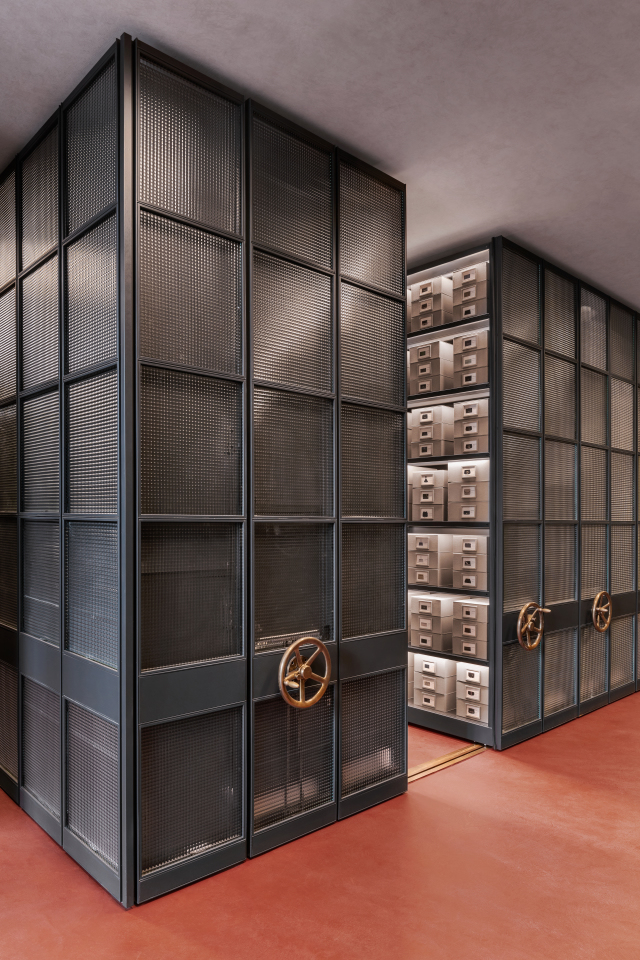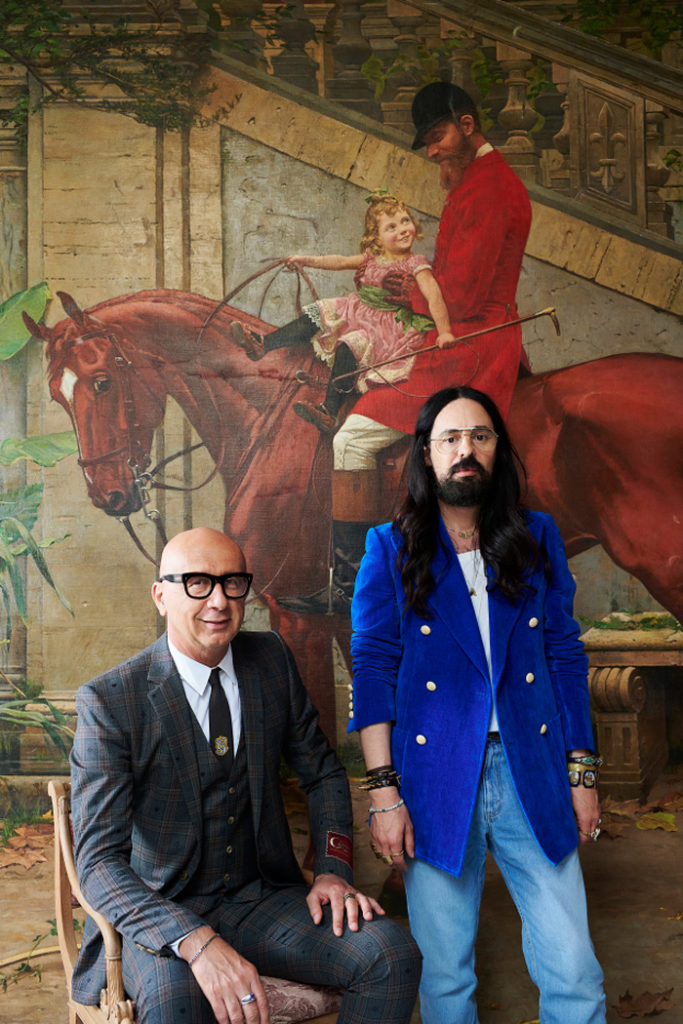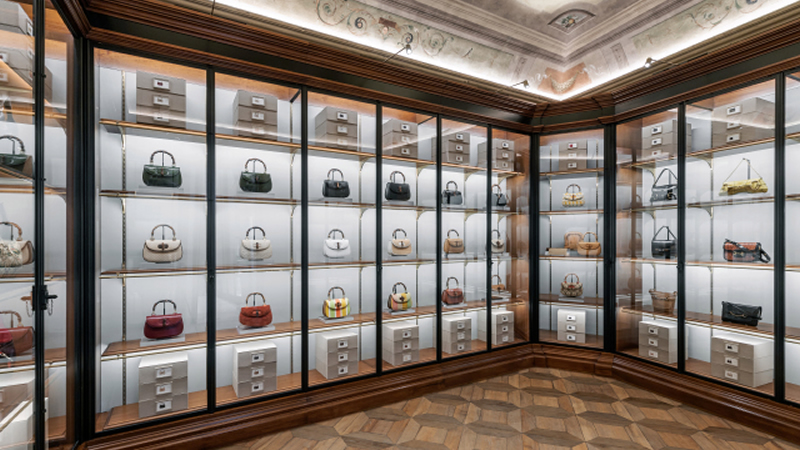Housed inside Palazzo Settimanni, the brand’s former headquarters in the city, the archive retraces the brand’s legacy in the year marking its 100th anniversary.
In the year marking its 100th anniversary, Gucci is celebrating its legacy while staying firmly focused on the future.
In conjunction with men’s trade fair Pitti Uomo, the brand has unveiled its archives here, a striking space covering 30,138 square feet conceived by creative director Alessandro Michele to gather under one roof the brand’s creations and pay homage to its 100-year history.
A few guests from the press were escorted inside the building, passing through the colonnaded courtyard filtering the blinding sun of a windy and blue-sky morning in Florence and were invited to discover the space nestled in the cobblestone street Via delle Caldaie in the Santo Spirito neighborhood.
The archive is housed inside the 16th-century Palazzo Settimanni, mentions of which date as far back as 1427, located on the left bank of the Arno river, where artisans and artists used to set up their ateliers and workshops and where the city’s aristocracy built their sumptuous villas close to Palazzo Pitti, where the Medici family had moved.
Palazzo Settimanni was acquired by Gucci in 1953 and over the course of seven decades was adapted to contain the brand’s first Florentine factory, as well as workshops and a showroom.
Signs of its past could be perceived in its restored version spearheaded by the house under the lead of Michele, who sought to bring the multilayered space back to its ancient beauty.
The five-story archives, including the ground floor and basement, were stripped of some recent additions to reveal traces of decorations, trompe l’oeil frescoes and mural paintings, which span three centuries from the 17th to the 19th.

Renovation work on the palazzo included removing a ’90s covering of the entrance hall to let natural light filter through the portico.
In a nod to its multipurpose past and the surrounding neighborhood filled with ateliers, Gucci conscripted local artisans to work on the renovation, including for the terra-cotta tile flooring seen on several floors.
Such details as furniture, glass cases, down to the lamps and handles of each door — the latter molded in the shape of scissors — were intended to exalt the house’s craftsmanship, which the archives aim to spotlight and preserve.
“Palazzo Settimanni, now free of earlier additions, is transformed into a magical place to which I have restored a sense of porousness: you pass through it, air gets in, you can walk through it as if it were a journey. I’m porous, absorbent, permeable,” explained Michele.
“I have restored to the palazzo a fairytale aura which, for instance, allows the small entrance hall to become a gateway to a dream dimension. I envisaged it as a sort of secret place within the house, an inner sanctum from where one sets out for Gucci’s holy lands,” he said.
Gucci called on Valerie Steele, director and chief curator of The Museum at the Fashion Institute of Technology, who offered her curatorial eye for the layout of some of the spaces.
“The archive is a memory palace,” she said. “Far from being a dusty attic, it is a dynamic system of knowledge production and inspiration.
Archives are based on the drive to collect and categorize objects from the past, not because of any nostalgia, but because the style of objects changes over time. This relation to time means that a brand like Gucci, which has a 100-year history, develops archives in order to keep a tangible cultural heritage alive, now and for the future.”
Each room on the three exhibition floors inside the palazzo is devoted to a different theme — and product category — as an homage to the brand’s history and named after Michele’s lexicon for the house, including “Radura” grouping ceramics and homeware; “Herbarium” for vintage stationery objects, and “Maison de L’Amour” for leisure articles from the ‘60s and ‘70s, which included vintage syrup cups and even an off-kilter mirror framed by a golden cornet.
The ground floor is entirely dedicated to accessories, with vintage handbags taking center stage in the “Swan” room, where different versions of signature styles including the Bamboo and Jackie bags are displayed inside glass and steel cases and retrace their evolution over the years — while proving their ability to stand the test of time.

A 1955 handbag featured the original horsebit hardware that has become a house signature element. Many of the styles are meticulously preserved inside armoires with a boat’s wheel-like handle, as in the “Hortus Deliciarum” room, the palazzo’s former garden with an ancient fountain.
The adjacent mirrored room, called “Le Marché des Merveilles,” highlights the house’s jewelry designs through the years, while small leather goods and luggage designs each have a dedicated space on the ground floor. In particular, luggage is displayed inside the “1921 Rifondazione” hall, named after the year the company was founded.
The first floor is dedicated to ready-to-wear, footwear and textile accessories such as scarves, twills and ties including some foulards bearing designs that illustrator and painter Vittorio Accornero de Testa created for the brand, such as the signature Flora pattern developed in 1966.
The painter’s preparatory drawings on paper hang on the walls. Other rooms on the floor house rtw pieces and footwear, catalogued according to the year and season they were first presented. Here, too, the rooms are named after Michele’s lexicon, with such monikers as “Aveugle Par Amour” and “Alchemist’s Garden.”
Celebrating its red-carpet credentials, Gucci installed a room called “Serapis,” which hosts a life-size, high-tech treasure chest.
Upon request and with the help of a dedicated technician the chest opens to reveal some of Michele’s best-known red-carpet gowns hanging on mannequins, including looks sported by celebrities including Lana Del Rey, Bjork and Dakota Johnson.
“My task was to bring many objects back home, virtually helping them return to the family. To a place which ostensibly preserves the past, but which is actually a bridge to the contemporary. An ancient building is a living thing. Like fashion,” said Michele.
Aiming for the space to bridge the past and present of the storied house, the Gucci archive — which is not open to the public — is also poised to become home to the Gucci Education initiative, which offers employees educational and training opportunities.
The Florentine space will flank the brand’s online education platform and community, which already offers training in fields including retail, supply chain, digital and human resources.
As reported, in 2018 Gucci also installed the “École de l’Amour,” or School of Love, workshop held at the company’s ArtLab industrial complex dedicated to leather goods and shoes, which it christened that same year in Scandicci, near Florence.



